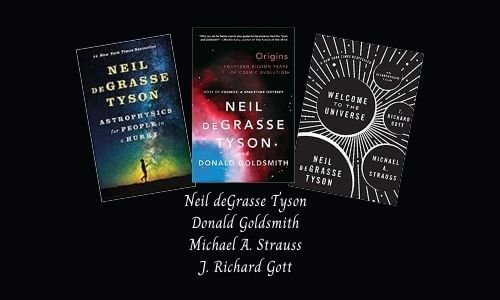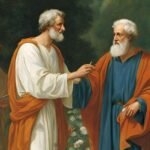Cosmology
What is Cosmology?
Cosmology is a branch of philosophy that deals with the origin and general structure of the universe.
It studies the various elements, laws, and evolution of the structure of the universe. It also studies the characteristics of space, time, causality, and freedom.
Stephen Hawking (January 1942 to March 2018) was the Lucasian Professor of Mathematics at the University of Cambridge for thirty years (1979-2009). He was a theoretical physicist, cosmologist, and director of research centre for theoretical cosmology at the University of Cambridge until he passed away.
He wrote several popular science books in which he discussed his own theories and cosmology.
His books for the general reader include A Brief History of Time, Black Holes and Baby Universes (a collection of essays), The Universe in a Nutshell.
He co-authored with Roger Penrose, The Nature of Space and Time and, with Leonard Mlodinow, The Grand Design.
Roger Penrose is the Rouse Ball Professor of Mathematics Emeritus at the University of Oxford.
Leonard Mlodinow is a physicist who taught at Cal Tech.
He has written for Star Trek: The Next Generation, and is the author of Euclid’s Window and Feynman’s Rainbow and the coauthor of the children’s book series The Kids of Einstein Elementary.
A Brief History of Time
A Brief History of Time published in 1988 was the best seller and gained worldwide acclaim and popularity. It was a landmark in science writing for readers with no prior knowledge of scientific theories.
Since early times humans have observed the night sky and celestial objects and pondered upon the origin and structure of the creation, and the fate of the universe.
The worldview of the universe has changed from the time of Aristotle (384 to 322 BC), Copernicus (1473 to 1543), Newton (1642 to 1726), and Einstein (1879 to 1955).
The book explores the origin, evolution, and future of the universe.
It reflects on the questions, such as;
How did the universe begin?
What is the structure of the universe?
What is the relationship between space and time?
Is the universe unending or are there boundaries?
Does time always flow forward in one direction? (arrow of time)
Are there other dimensions in space?
Are there many universes?
What will happen when it all ends?
The book plunges into the exotic realms of big bang, black holes, quarks and antimatter, real and imaginary time, string theory, and multi-verses.
With exciting images and profound imagination, Stephen Hawking brings us closer to the secrets at the very heart of creation.
Excerpts form the book:
Even if there is only one possible unified theory, it is just a set of rules and equations. What is it that breathes fire into the equations and makes a universe for them to describe? The usual approach of science of constructing a mathematical model cannot answer the questions of why there should be a universe for the model to describe. Why does the universe go to all the bother of existing?
Any physical theory is always provisional, in the sense that it is only a hypothesis: you can never prove it. No matter how many times the results of experiments agree with some theory, you can never be sure that the next time the result will not contradict the theory.
In the eighteenth century, philosophers considered the whole of human knowledge, including science, to be their field and discussed questions such as: Did the universe have a beginning? However, in the nineteenth and twentieth centuries, science became too technical and mathematical for the philosophers, or anyone else except a few specialists. Philosophers reduced the scope of their inquiries so much that Wittgenstein, the most famous philosopher of this century, said, “The sole remaining task for philosophy is the analysis of language.” What a comedown from the great tradition of philosophy from Aristotle to Kant!
There could be whole antiworlds and antipeople made out of antiparticles. However, if you meet your anti-self, don’t shake hands! You would both vanish in a great flash of light.
The Nature of Space and Time
The Nature of Space and Time contains a series of lectures by Hawking and Penrose, renowned professors at Cambridge and Oxford, respectively.
The authors present alternative views on approaching a formulation that fully accommodates both quantum (smallest scale of energy level) and general relativity (large scale: space-time and gravity) theories in physics.
The overall topic is how mathematical physics might best represent the realities of the universe.
Einstein said that the most incomprehensible thing about the universe is that it is comprehensible.
Can the quantum theory of fields and Einstein’s general theory of relativity, the two most accurate and successful theories in all of physics, be united in a single quantum theory of gravity?
Can quantum and cosmos ever be combined? On this issue, two of the world’s most famous physicists, Stephen Hawking and Roger Penrose disagree.
They explain their positions in a work based on six lectures with a final debate, presented at the Isaac Newton Institute for Mathematical Sciences at the University of Cambridge.
How could quantum gravity, a theory that could explain the earlier moments of the big bang and the physics of the enigmatic objects known as black holes, be constructed?
Why does our patch of the universe look just as Einstein predicted, with no hint of quantum effects in sight?
What strange quantum processes can cause black holes to evaporate, and what happens to all the information that they swallow?
Why does time go forward, not backward?
In this book, the two opponents touch on all these questions.
Penrose, like Einstein, refuses to believe that quantum mechanics is a final theory.
Hawking thinks otherwise and argues that general relativity simply cannot account for how the universe began. Only a quantum theory of gravity, coupled with the no-boundary hypothesis, can ever hope to explain adequately what little we can observe about our universe.
Penrose, playing the realist to Hawking’s positivist, thinks that the universe is unbounded and will expand forever.
The universe can be understood, he argues, in terms of the geometry of light cones, the compression and distortion of space time, and using twistor theory.
In the final debate, the reader will come to realize how much Hawking and Penrose diverge in their opinions of the ultimate quest to combine quantum mechanics and relativity, and how differently they have tried to comprehend the incomprehensible.
The Grand Design
The Grand Design is a popular-science book written by physicists Stephen Hawking and Leonard Mlodinow and published by Bantam Books in 2010. It became best seller in USA and UK.
In this startling and lavishly illustrated book, Stephen Hawking and Leonard Mlodinow present the most recent scientific thinking about the mysteries of the universe, in non-technical language marked by brilliance and simplicity.
In ancient times the questions about the universe were scrutinized, discussed, and presented under Philosophy (Greek for “love of wisdom”).
Philosophy included every area of learning, such as, mathematics, physics, astronomy, medicine, sociology, politics etc.
In modern era, with the development of instruments and experiments, some of the investigations that were traditionally part of philosophy became separate academic disciplines, such as, mathematics, physics, astronomy, medicine, psychology, sociology, linguistics, and economics etc.
Other general investigations, such as, law, journalism, politics, religion, science, business and various art and entertainment activities remain a part of Philosophy.
Until the advent of modern physics it was generally thought that all knowledge of the world could be obtained through direct observation as perceived through our senses.
This view is no longer compatible with modern physics as there are many factors that cannot be directly perceived through our senses.
It is based on the idea that our brains interpret the input from our sensory organs by making a model of the world. When such a model is successful at explaining events, we tend to attribute to it, and to the elements and concepts that constitute it, the quality of reality or absolute truth.
But there may be different ways in which one could model the same physical situation, with each employing different fundamental elements and concepts. If two such physical theories or models accurately predict the same events, one cannot be said to be more real than the other; rather, we are free to use whichever model is most convenient.
In the history of science, we have discovered a sequence of better and better theories or models, from Aristotle to the classical theory of Newton to modern relativity and quantum theories by Einstein.
It is natural to ask: Will this sequence eventually reach an end point, an ultimate theory of the universe, that will include all forces and predict every observation we can make, or will we continue forever finding better theories, but never one that cannot be improved upon?
We do not yet have a definitive answer to this question, but we now have a candidate for the ultimate theory of everything, if indeed one exists, called M- theory.
M-theory is the only model that has all the properties we think the final theory ought to have, and it is the theory upon which much of our later discussion is based.
M-theory is a whole family of different theories, each of which is a good description of observations only in some range of physical situations.
M-theory predicts that a great many universes were created out of nothing. Each universe has many possible histories and many possible states at later times, that is, at times like the present, long after their creation.
Most of these states will be quite unlike the universe we observe and quite unsuitable for the existence of any form of life. Only a very few would allow creatures like us to exist.
Thus, our presence selects out from this vast array only those universes that are compatible with our existence. Although we are puny and insignificant on the scale of the cosmos, this makes us in a sense the lords of creation.
How can we understand the world in which we find ourselves?
How does the universe behave?
What is the nature of reality?
Where did all this come from?
Did the universe need a creator?
Excerpts from the book:
Each exists for but a short time, and in that time explore but a small part of the whole universe.
Consider the apparent dimension of the universe. According to M-theory, space-time has ten space dimensions and one time dimension. The idea is that seven of the space dimensions are curled up so small that we don’t notice them, leaving us with the illusion that all that exist are the three remaining large dimensions we are familiar with.
How do I know that a table still exists if I go out of the room and can’t see it? What does it mean to say that things we can’t see, such as electrons or quarks—the particles that are said to make up the proton and neutron—exist? One could have a model in which the table disappears when I leave the room and reappears in the same position when I come back, but that would be awkward, and what if something happened when I was out, like the ceiling falling in? How, under the table-disappears-when-I-leave-the-room model, could I account for the fact that the next time I enter, the table reappears broken, under the debris of the ceiling? The model in which the table stays put is much simpler and agrees with observation. That is all one can ask.
Quantum physics tells us that no matter how thorough our observation of the present, the (unobserved) past, like the future, is indefinite and exists only as a spectrum of possibilities.
The universe, according to quantum physics, has no single past, or history. The fact that the past takes no definite form means that observations you make on a system in the present affect its past.
Theory of Everything
In this series of lectures Stephen Hawking tries to give an outline of what we think is the history of the universe from the big bang to black holes.
The first lecture briefly reviews past ideas about universe and how we got to our present picture. One might call this the history of the universe.
The second lecture describes how both Newton’s and Einstein’s theories of gravity led to the conclusion that the universe could not be static: it had to be either expanding or contracting. This, in turn, implied that there must have been a time between ten and twenty billion years ago when the density of the universe was infinite. This is called the big bang. It would have been the beginning of the universe.
The third lecture talks about the black holes. These are formed when a massive star or an even larger body collapses in on itself under its own gravitational pull.
According to Einstein’s general theory of relativity, any one foolish enough to fall into a black hole will be lost forever. They will not be able to come out of the black hole again. Instead, history, as far as they are concerned will come to a sticky end at a singularity.
However, general relativity is a classical theory, that is, it does not consider the uncertainty principle of quantum mechanics.
The fourth lecture describes how quantum mechanics allows energy to leak out of black holes. Black holes are not as black as they are painted.
The fifth lecture shall apply quantum mechanical ideas to the big bang and the origin of the universe. This leads to the idea that space-time may be finite in extent but without boundary or edge. It would be like the surface of the earth but with two more dimensions.
The sixth lecture shows how this boundary proposal could explain why the past is so different from the future, even though the laws of physics are time symmetric.
Finally, in the seventh lecture Stephen W. Hawking describes how we are trying to find a unified theory that will include quantum mechanics, gravity, and all other theories into a single theory to describe the universe.
Excerpts from the book:
“We now know that our galaxy is only one of some hundred thousand million that can be seen using modern telescopes, each galaxy itself containing some hundred thousand million stars. We live in a galaxy that is about one hundred thousand light-years across and is slowly rotating: the stars in its spiral arms orbit around its center about once every hundred million years. Our sun is just an ordinary, average-sized, yellow star, near the outer edge of one of the spiral arms.”
“The matter in the universe is made out of positive energy. However, the matter is all attracting itself by gravity. Two pieces of matter that are close to each other have less energy than the same two pieces a long way apart. This is because you have to expend energy to separate them. You have to pull against the gravitational force attracting them together. Thus, in a sense, the gravitational field has negative energy. In the case of the whole universe, one can show that this negative gravitational energy exactly cancels the positive energy of the matter. So the total energy of the universe is zero.”
“As often happens in science, discoveries are made in the pursuit of an elusive (and sometimes nonexistent) goal.”







